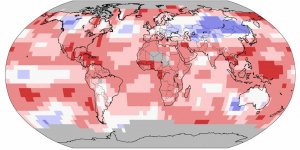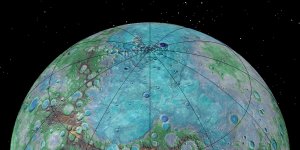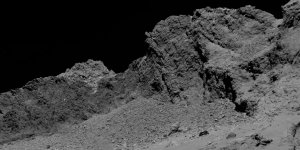Science News

In October, La Niña’s presence started to be felt, as global temperatures cooled from the record warm conditions experienced earlier in the year. »

Researchers found that neurons activated by the “social hormone” oxytocin lessen anxiety in male mice, but not females. »

The number of discovered near-Earth asteroids (NEAs) now tops 15,000, with an average of 30 new discoveries added each week. This milestone marks a 50 percent increase in the number of known NEAs since 2013, when discoveries reached 10,000 in August of that year. »

2016 TB57 is a small asteroid that will come closest to Earth on Oct. 31 at just beyond five times the distance of the moon. »

Two new studies by researchers at NASA and the University of California, Irvine, detect the fastest ongoing rates of glacier retreat ever observed in West Antarctica and offer an unprecedented direct view of intense ice melting from the floating undersides of glaciers. »

A network of diverse Internet-connected devices targeted the Dyn domain registration service provider. It took down Dyn clients, including several popular websites such as Twitter, Netflix, Spotify, Reddit, New York Times, and Wired. »

Scientists are studying the skeleton of an ancient sea monster. It was discovered in Scotland 50 years ago, but it wasn’t until more recently -- using modern fossil extraction methods — that the bones could be pulled out of hard rock. The previously unknown reptile lived in the oceans during the time of the dinosaurs. »

With the help of two young patients with a unique neurological disorder, an initial study by scientists at the National Institutes of Health suggests that a gene called PIEZO2 controls specific aspects of human touch and proprioception, a “sixth sense” describing awareness of one’s body in space. »

Researchers identified brain cells responsible for boosting memory retention in mice when they have novel experiences. »

It’s small, it’s hot, and it’s shrinking. New NASA-funded research suggests that Mercury is contracting even today, joining Earth as a tectonically active planet. »

A new image of comet 67P/Churyumov-Gerasimenko was taken by the European Space Agency's Rosetta spacecraft shortly before its controlled impact into the comet's surface on Sept. 30, 2016. »

The puzzling appearance of an ice cloud seemingly out of thin air has prompted NASA scientists to suggest that a different process than previously thought -- possibly similar to one seen over Earth's poles -- could be forming clouds on Saturn's moon Titan. »

A group of scientists of the Assam Agricultural University of Assam, India has claimed the Bhut Jolokia, which was once recorded as the hottest chilli in the world in the Guinness World Records, is losing its characteristic hotness with time. »
Researchers used computer simulations to screen millions of molecules for opioid-like pain-relieving properties. The analyses allowed scientists to create a molecule that effectively alleviates pain in mice, but with fewer side effects than the opioid morphine. »
Supermassive black holes, with their immense gravitational pull, are notoriously good at clearing out their immediate surroundings by eating nearby objects. When a star passes within a certain distance of a black hole, the stellar material gets stretched and compressed -- or "spaghettified" -- as the black hole swallows it. »
An analysis of satellite data showed that at 1.60 million square miles (4.14 million square kilometers), the 2016 Arctic sea ice minimum extent is effectively tied with 2007 for the second lowest yearly minimum in the satellite record. »
ESA's Planck satellite, a mission with significant participation from NASA, has revealed that the first stars in the universe started forming later than previous observations of the cosmic microwave background indicated. »
An Atlas V rocket traced a blazing arc into the Florida sky Thursday evening to send a small robotic explorer on its way to an asteroid on a mission that scientists anticipate will reveal answers to some of the basic questions about the solar system. »
The seasonality of bird migration is shifting in response to climate change. As a result, birds in the United States are arriving at their northern breeding grounds earlier in spring -- and may be departing later in fall. »
A lonely 3-mile-high (5-kilometer-high) mountain on Ceres is likely volcanic in origin, and the dwarf planet may have a weak, temporary atmosphere. »
Astronomers studying distant galaxies powered by monster black holes have uncovered an unexpected link between two very different wavelengths of the light they emit, the mid-infrared and gamma rays. »
National Institutes of Health researchers have discovered a rare and sometimes lethal inflammatory disease, otulipenia, that primarily affects young children. »

Using data collected by NASA’s Stratospheric Observatory for Infrared Astronomy (SOFIA) and other observatories, an international team of researchers has studied how a particular type of organic molecules, the raw materials for life – could develop in space. »
Scientists from James Cook University and Ohio University discovered the oldest known examples of "fungus gardens" in 25 million-year-old fossil termite nests in East Africa. »
Earlier annual snowmelt periods may hinder the ability of forests to regulate atmospheric carbon dioxide (CO2). »
The new data suggest that Ceres has a weak interior, and that water and other light materials partially separated from rock during a heating phase early in its history. »
The cataclysmic 1991 eruption of Mount Pinatubo in the Philippines masked the full impact of greenhouse gases on accelerating sea level rise, according to a new study. »

Rhea, like many moons in the outer solar system, appears dazzlingly bright in full sunlight. This is the signature of the water ice that forms most of the moon's surface. »
Tree sloths are among the most emblematic tree-dwelling mammals. They are best known for their pokey demeanor rather than the fact that they spend the majority of their lives in trees munching leaves. But the slow-motion lifestyle of tree sloths, according to a new study, is a direct result of the animals' adaptation to their arboreal niche. »
Researchers developed a strategy to treat a rare autoimmune disease called pemphigus vulgaris and demonstrated its potential in a mouse model. »
Plant biologists discover how sunflowers use internal circadian timing to follow the sun. »
Ceres is covered in countless small, young craters, but none are larger than 175 miles (280 kilometers) in diameter. To scientists, this is a huge mystery, given that the dwarf planet must have been hit by numerous large asteroids during its 4.5 billion-year lifetime. Where did all the large craters go? »
By following Honeyguides, a species of bird, people in Africa are able to locate bees’ nests to harvest honey. Research now reveals that humans use special calls to solicit the help of honeyguides and that honeyguides actively recruit appropriate human partners. »
Research has identified brain patterns in humans that appear to underlie “resilient coping,” the healthy emotional and behavioral responses to stress that help some people handle stressful situations better than others. »
Researchers used computer modeling to show how the spleen maintains the quality of red blood cells in the bloodstream. »
The JunoCam camera aboard NASA's Juno mission is operational and sending down data after the spacecraft's July 4 arrival at Jupiter. Juno's visible-light camera was turned on six days after Juno fired its main engine and placed itself into orbit around the largest planetary inhabitant of our solar system. »
Scientists with NASA's Dawn mission have identified permanently shadowed regions on the dwarf planet Ceres. Most of these areas likely have been cold enough to trap water ice for a billion years, suggesting that ice deposits could exist there now. »
NASA's Juno spacecraft will make its long anticipated arrival at Jupiter on July 4. Coming face-to-face with the gas giant, Juno will begin to unravel some of the greatest mysteries surrounding our solar system's largest planet, including the origin of its massive magnetosphere. »
The brightest area on Ceres, located in the mysterious Occator Crater, has the highest concentration of carbonate minerals ever seen outside Earth, according to a new study from scientists on NASA's Dawn mission. »
Pain can help protect the body after an injury or infection. It serves as a warning system to rest or avoid certain activities. But sometimes, pain may become chronic. This can happen when nerve cells that detect something harmful alter the electrical or molecular signals they send to the spinal cord. »
Remote lakes in a perpetually ice-free area of Antarctica show not only the chemical signature of ancient wildfires, but also some much more recent evidence of fossil-fuel combustion. »
The Earth passed another unfortunate milestone May 23 when carbon dioxide surpassed 400 parts per million (ppm) at the South Pole for the first time in 4 million years. »
A small asteroid has been discovered in an orbit around the sun that keeps it as a constant companion of Earth, and it will remain so for centuries to come. »
The Milky Way, the brilliant river of stars that has dominated the night sky and human imaginations since time immemorial, is but a faded memory to one-third of humanity and 80 percent of Americans, according to a new global atlas of light pollution produced by Italian and American scientists. »
Geophysical monitoring of the ground above active supervolcanoes, like the one located in Yellowstone National Park, shows that it rises and falls as magma moves beneath the surface of the Earth. »
The International Union of Pure and Applied Chemistry (IUPAC) announced the proposed names of four chemical elements recently discovered by scientists around the world. »
Electrical stimulation of the spinal cord, called epidural stimulation, helped 2 people with quadriplegia improve voluntary movement and use of their hands. »
Human activity has increased the direct warming effect of carbon dioxide in the atmosphere by 50 percent above pre-industrial levels during the past 25 years, according to NOAA's 10th Annual Greenhouse Gas Index. »
An international team of 60 scientists, working together as the 2ndFOR Network, has completed studies on the effects of forest conservation and secondary forest regeneration across 43 regions in Latin America. »
An international team of researchers has identified 74 areas of the human genome associated with educational attainment. It is well known that social and other environmental factors influence education, but these findings suggest that large genetics analyses may be able to help discover biological pathways as well. »